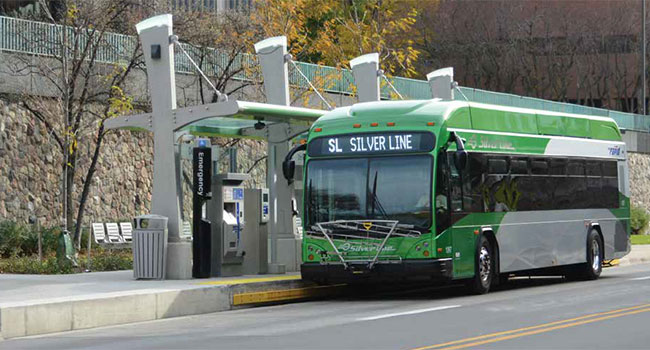
Bus Lanes Get a Makeover
The Rapid riders will have access to First Responders
- By Michael Zuidema
- Feb 01, 2015
The Rapid bus system in Grand Rapids, Mich. has had its share of
heated debates over the past several years, with detractors bemoaning
its lack of use and proponents promising major economic benefits
with expansion.
In the spring of 2013, The Rapid started construction on the
Silver Line’s 33 new stations that run up and down a rejuvenated Division Avenue
that’s rife with construction projects currently in progress and winds through
downtown Grand Rapids and the city’s “Medical Mile” district. The 9.6-mile, $40
million project included street and sidewalk improvements.
When the project is 100 percent completed, 10 brand-new buses will have dedicated
lanes and signal preference when they are approaching a green light. Additionally,
each bus stop will have real-time arrival displays, bike racks, seating and
handicap accessibility.
Direct Access
But, one thing The Rapid made certain to include was a way for riders to have direct
access with first responders. That’s where Code Blue Corporation of Holland,
Mich. was able to step in by providing an emergency communication solution at
each bus stop.
With the assistance of Midstate Security of Wyoming, Mich., The Rapid selected
the CB 1-e, a 9-foot tall pedestal Help Point from Code Blue known for its
rugged durability and high visibility that was then shortened to a custom height
to meet the specific requirements of each bus stop. Included with all of the units
was a sophisticated IA4100 analog emergency speakerphone with a custom button
and faceplate clearly instructing riders that their calls will be routed to 911.
Managing the entire system is Code Blue’s award-winning ToolVox, an efficient,
easy-to-use management platform that remotely provisions and monitors the
status of the emergency units.
Having worked on similar projects for a number of public transportation locations—
including the Charlotte Area Transit System in North Carolina, the
Nashville Metro Transit Authority and the Mass Bay Transit Authority in Boston—
Code Blue embraces the need to provide a way for authorities to respond to
emergency situations.
“It is vital that riders feel safe by having a direct line of communication with
first responders,” said David Cook, COO at Code Blue.
Additionally, The Rapid had surveillance cameras installed at each stop, along
with five cameras on board each bus for additional safety and security precautions.
All of these measures ensure that riders are never far from help if an incident
occurs.
It’s one reason why The Rapid was named the 2013 “Outstanding Mid-Size Transportation
System” by the American Public Transportation Association (APTA).
“Individuals, families and the entire community all benefit from public transportation and it will be even more important in
peoples’ lives in the years to come,” wrote Michael P.
Melaniphy, president and CEO of APTA, in a guest
column for Mlive.com. “I am so impressed with The
Rapid and was privileged last month to see for myself
how it is not only serving the people of your region,
but is serving as a model of excellence for other public
transit systems to emulate.”
This may end up being a key component considering
how popular the Silver Line has been in its nascence.
Service started on Aug. 25, and drew an average of
2,500 riders per day during its first week, according
to The Rapid.
“The Silver Line has been in the works for more
than 10 years. Throughout that time, we’ve stayed
focused on keeping the project moving forward and
it was a great day to see it finally in operation,” said
Peter Varga, CEO of The Rapid. “We’ve had a strong
opening and are excited to see the growth over the
coming months and years.”
It has been billed as Michigan’s first bus rapid
transit line and is expected to shave 40 percent off
commute times, which leaders hope will spark economic
investment and improve upon the record 12.5
million riders the line saw in 2013. One frequently
cited model is Cleveland’s public transportation system,
which has stimulated an estimated $6 million in
development since 2008. Similar successes with routes
in Phoenix and in Eugene, Ore. have leaders at The
Rapid excited.
“One of the points of this project is economic development,”
said Conrad Venema, strategic planning
manager at The Rapid. “We’ve seen in other areas,
where cities have leveraged these
kinds of projects, that they’ve been
able to turn property values around
significantly.”
This article originally appeared in the February 2015 issue of Security Today.
About the Author
Michael Zuidema is the communications manager for Code Blue Corp.